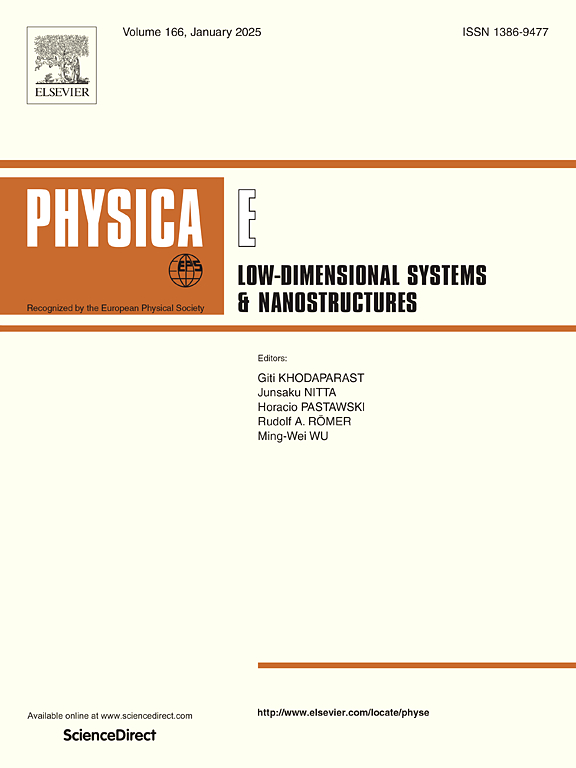Effect of the tilt on the three-dimensional quantum Hall effect in tilted Weyl semimetals
IF 2.9
3区 物理与天体物理
Q3 NANOSCIENCE & NANOTECHNOLOGY
Physica E-low-dimensional Systems & Nanostructures
Pub Date : 2025-05-27
DOI:10.1016/j.physe.2025.116289
引用次数: 0
Abstract
Three-dimensional (3D) quantum Hall effect (QHE) in Weyl semimetal has attracted intense interests recent years. In this paper, we theoretically investigate the 3D QHE in tilted Weyl semimetals from bulk states for magnetic field parallel to the separation of Weyl nodes. According to the correspondence between bulk Chern number and Hall conductivity, we analytically calculate the Hall conductivity as a function of Fermi energy and the tilted terms in a thin film of a tilted Weyl semimetal using periodic boundary condition. The width of the Hall plateaus as a function of Fermi energy is influenced by the tilted terms and the energy gap between the and Landau levels (LLs). When the two Weyl nodes tilt to the same direction and tilt away from each others, the plateau width decreases as a quadratic function and linear function respectively as the tilt increases. When the two Weyl nodes tilt towards to each other, the plateau width increases as a linear function. However, the width is limited by the energy gap between the and LLs which decreases as the tilt increases. We also numerically calculate the Hall conductivity using open boundary condition and the numerical results show well consistent with the analytical results. Our study can be significant for understanding the effects of tilt on the 3D QHE in tilted Weyl semimetals.
倾斜对倾斜Weyl半金属中三维量子霍尔效应的影响
Weyl半金属中的三维量子霍尔效应(QHE)近年来引起了人们的广泛关注。本文从理论上研究了平行于Weyl节点分离的磁场下倾斜Weyl半金属体态的三维QHE。根据体陈恩数与霍尔电导率的对应关系,利用周期边界条件解析计算了倾斜Weyl半金属薄膜中费米能量与倾斜项的函数关系。霍尔高原的宽度作为费米能量的函数受到倾斜项和n= - 1和n=1朗道能级(LLs)之间的能隙的影响。当两个Weyl节点向同一方向倾斜并相互远离时,平台宽度分别随着倾斜的增加而呈二次函数和线性函数减小。当两个Weyl节点相互倾斜时,平台宽度呈线性函数增加。然而,宽度受到n= - 1和n=1 LLs之间的能量间隙的限制,该能量间隙随着倾角的增加而减小。在开边界条件下对霍尔电导率进行了数值计算,结果与解析结果吻合较好。我们的研究对于理解倾斜对倾斜Weyl半金属三维QHE的影响具有重要意义。
本文章由计算机程序翻译,如有差异,请以英文原文为准。
求助全文
约1分钟内获得全文
求助全文
来源期刊
CiteScore
7.30
自引率
6.10%
发文量
356
审稿时长
65 days
期刊介绍:
Physica E: Low-dimensional systems and nanostructures contains papers and invited review articles on the fundamental and applied aspects of physics in low-dimensional electron systems, in semiconductor heterostructures, oxide interfaces, quantum wells and superlattices, quantum wires and dots, novel quantum states of matter such as topological insulators, and Weyl semimetals.
Both theoretical and experimental contributions are invited. Topics suitable for publication in this journal include spin related phenomena, optical and transport properties, many-body effects, integer and fractional quantum Hall effects, quantum spin Hall effect, single electron effects and devices, Majorana fermions, and other novel phenomena.
Keywords:
• topological insulators/superconductors, majorana fermions, Wyel semimetals;
• quantum and neuromorphic computing/quantum information physics and devices based on low dimensional systems;
• layered superconductivity, low dimensional systems with superconducting proximity effect;
• 2D materials such as transition metal dichalcogenides;
• oxide heterostructures including ZnO, SrTiO3 etc;
• carbon nanostructures (graphene, carbon nanotubes, diamond NV center, etc.)
• quantum wells and superlattices;
• quantum Hall effect, quantum spin Hall effect, quantum anomalous Hall effect;
• optical- and phonons-related phenomena;
• magnetic-semiconductor structures;
• charge/spin-, magnon-, skyrmion-, Cooper pair- and majorana fermion- transport and tunneling;
• ultra-fast nonlinear optical phenomena;
• novel devices and applications (such as high performance sensor, solar cell, etc);
• novel growth and fabrication techniques for nanostructures

 求助内容:
求助内容: 应助结果提醒方式:
应助结果提醒方式:


